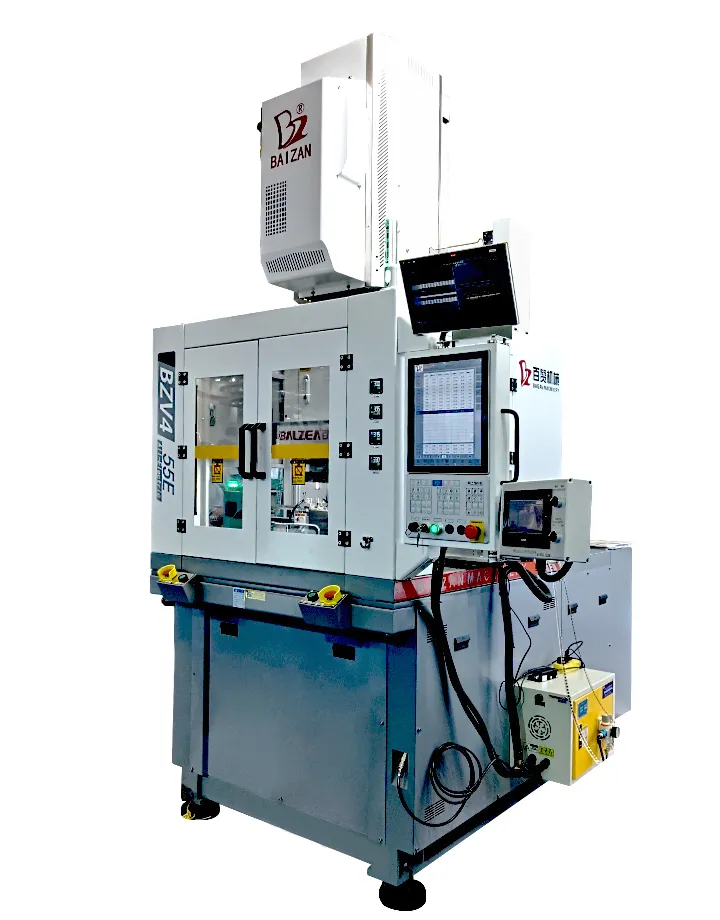Vertical injection molding machine is a type of thermoplastic or thermoset plastic molding machine that operates vertically. It uses a vertical clamp, where the mold is loaded from the bottom of the machine, and the injection unit is located above the mold. This design allows for easy and quick mold changes and reduces floor space requirements.
There are mainly three types of vertical injection molding machines: shuttle table, rotary table, and shuttle rotary table. Each type has its own advantages and suitable applications.
1. Shuttle table machine: In this type of machine, the mold moves horizontally in and out of the machine. It is best suited for small and medium-sized parts with relatively simple geometries. The mold can be loaded manually or automatically using a robot. It has a compact design and a low price, making it ideal for smaller production volumes.
2. Rotary table machine: In this type of machine, the mold rotates around a vertical axis. It can accommodate multiple molds, allowing for the production of multiple parts in each cycle. This machine is suitable for complex parts with multiple cavities or for overmolding operations. It has a higher production capacity and is more suitable for high-volume production.
3. Shuttle rotary table machine: It combines the features of both the shuttle table and rotary table machine. The mold moves both horizontally and vertically and can rotate around a vertical axis. This type of machine is ideal for large and complex parts that require a combination of different processes, such as injection molding and insert molding. It offers flexibility and versatility in production, but it is also more expensive than the other two types.
When choosing a vertical injection molding machine, there are several factors that need to be considered.
1. Type of material: The type of material to be used for injection molding plays a crucial role in selecting the machine. Different materials have different characteristics, such as viscosity and melting point, which can affect the choice of machine.
2. Part size and complexity: The size and complexity of the part also determine the type of machine to be used. Larger and more complex parts may require a rotary or shuttle rotary table machine, while smaller and simpler parts can be produced on a shuttle table machine.
3. Production volume: The anticipated production volume also plays a crucial role in selecting the machine. A high-volume production would require a machine with a higher production capacity, while a low-volume production can be accommodated by a smaller machine.
4. Cost: The cost of the machine is also a significant factor in the decision-making process. Shuttle table machines are the least expensive, while rotary table and shuttle rotary table machines are more expensive due to their advanced features and capabilities.
5. Automation: The level of automation required also influences the choice of machine. Shuttle rotary table machines offer the highest level of automation, followed by rotary table machines, while shuttle table machines require more manual intervention.
6. Mold compatibility: It is essential to ensure that the machine is compatible with the mold design. The size and shape of the mold should fit the machine's clamp and the injection unit.
the selection of a vertical injection molding machine depends on factors such as the type of materials, part size and complexity, production volume, cost, automation level, and mold compatibility. It is essential to consider all these factors to choose the most suitable machine for the production requirements.

Description of Vertical Injection Molding Machine:
Our Vertical Injection Molding Machine is a high-performing equipment perfect for producing small to medium sized plastic components. Its compact design and vertical clamping mechanism make it suitable for limited workspace and efficient in operation. Equipped with an advanced control system, it ensures precise and stable molding process, resulting in high-quality products. It also features a user-friendly interface, allowing for easy set-up and operation. Its overall performance and reliability make it an ideal choice for various industries such as electronics, automotive, and medical.
1.What is the role of a mold in vertical injection molding?
A mold is a critical component of a vertical injection molding machine as it holds the molten plastic and determines the shape and features of the molded part. The quality of the mold directly affects the quality and precision of the final product, making it an important factor to consider in the production process.
2.Can a vertical injection molding machine produce 3D models?
No, a vertical injection molding machine is not capable of producing 3D models. It is limited to producing solid objects with a fixed shape and structure.
3.How does a vertical injection molding machine handle air in the mold?
Air in the mold can be removed by using a vacuum system during the injection process. This ensures the molten plastic fills all areas of the mold and creates a complete and accurate part.
4.Can a vertical injection molding machine be used for overmolding?
Yes, a vertical injection molding machine can be used for overmolding, which is the process of molding one material over another. This technique is commonly used to create products with soft-touch grips, multiple colors, or to combine different materials with different properties.

5.What factors should be considered when choosing a vertical injection molding machine?
When choosing a vertical injection molding machine, factors such as clamping force, mold size, and injection volume should be considered. It is also important to consider the types of parts being produced and the required precision and speed.